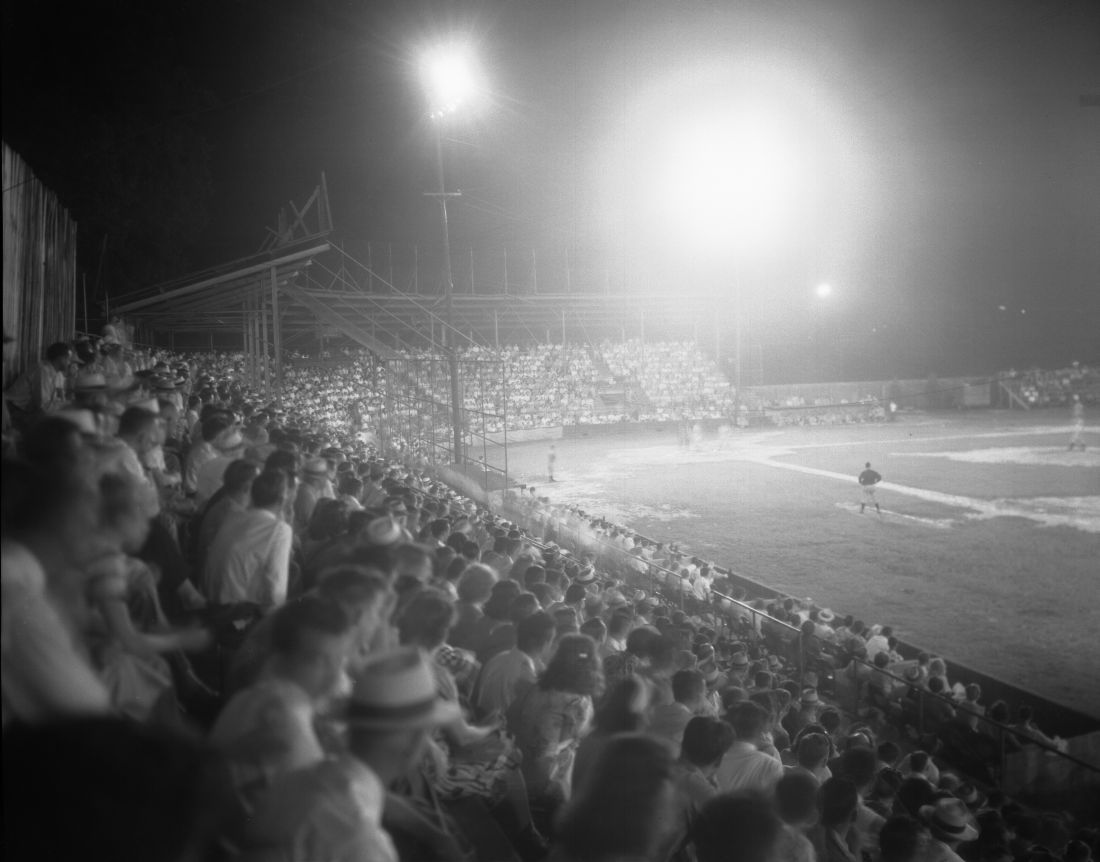When Raleigh is mentioned as a serious contender for a Major League Baseball expansion franchise, the reaction is often a mix of disdain and disbelief.
“People say, ‘Really? Raleigh?’” said Wayne McDonnell of Concord, who taught at the University of North Carolina at Chapel Hill and is an associate professor of the practice in sports industry management at Georgetown University. “Funny thing is, when you start laying everything out, they go, ‘It makes total sense.’”
MLB last expanded 27 years ago but is nearly certain to select two new teams by 2029, when Commissioner Rob Manfred retires. For seven years, a growing coalition of advocates has built a case for Raleigh.
The pioneer is the MLB Raleigh campaign, conceived at a downtown bar in 2018 when two friends, Lou Pascucci and Ryan Foose, were watching a game and saw a clip about expansion contenders.
📨 STATEWIDE
Stories that matter. Stories shaping North Carolina.
Join thousands of North Carolinians in-the-know about their state. Sign up, the newsletter’s free. Every Monday, Wednesday, and Friday.
“He and I were like, ‘Why is Raleigh never listed?’” Pascucci told The Assembly. They dug into the demographic and economic data that could determine success—including population within an hour’s drive, media market size, and median income—“and Raleigh looked amazing in all of them,” Pascucci said.
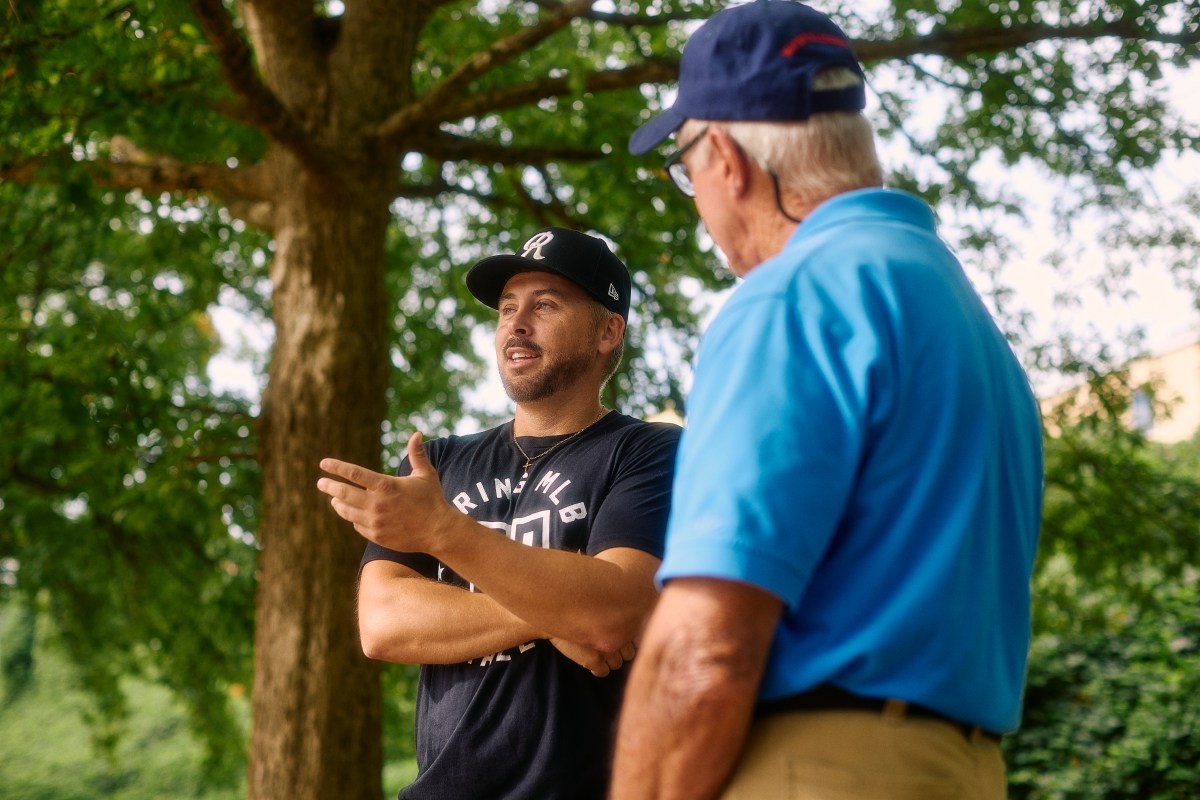 Lou Pascucci talks to Dwight Nipper near the former site of Raleigh’s minor league baseball stadium. (Tyler Northrup for The Assembly)
Lou Pascucci talks to Dwight Nipper near the former site of Raleigh’s minor league baseball stadium. (Tyler Northrup for The Assembly)
Pascucci, Foose, and another fan, Will Gadd, founded MLB Raleigh to amplify the conversation. The campaign has been using meetups, media appearances, and a website full of data to raise awareness. They’ve also sold merchandise, including a ball cap with the Raleigh area code “919” embedded in a home plate logo, to support local youth baseball.
Mayor Janet Cowell, Gov. Josh Stein and former Gov. Roy Cooper have expressed support. Most importantly, Carolina Hurricanes owner Tom Dundon, whose net worth is estimated at $1.5 billion, says he’s committed to landing a team. Raleigh is now on nearly every pundit’s short list.
But if the MLB team owners, who will determine the location of the new franchises, want to see proof of concept, Raleigh has a challenge. Because of unfortunate timing, changing economics, personal preferences, and the game’s own rules, there has been no professional baseball, on any level, in Raleigh for 54 years. It’s the largest U.S. city without pro ball within 20 miles of its center.
When the stats are aggregated, when the ledger sheets are opened, when the politicians are heard, the hardest question to answer might be the intangible: Is Raleigh truly a Major League Baseball town?
When Yaz Roamed Raleigh
Raleigh does have a rich, though distant, history with pro baseball.
No trace remains of its first home for minor league ball, League Park, built in 1912 on the south side of New Bern Avenue in East Raleigh, at the end of a streetcar line. The spot where future Detroit Tigers Hall of Fame first baseman Hank Greenberg stretched for throws in the dog days of 1930 is now the backyard of a house on Tarboro Road.
But the stadium had a good run. Raleigh had a minor league team for five seasons starting in 1913, and for 12 years after World War I, nicknamed the Red Birds, Nats, and then the name that stuck: Capitals. League Park got lights in 1931–four years before the major leagues held their first night game at Crosley Field in Cincinnati.
Lifelong Raleigh resident Marshall Wyatt, 75, remembers a League Park story told by his father, Edgar: “They’d get a nickel together, and they’d get on the streetcar. When the driver got there he’d take a break, and the streetcar would just sit there for 20 or 30 minutes. My dad and his buddies would crawl out and climb onto the roof of the streetcar, and they could see over the fence into the ballpark.”
The Depression was the first test of Raleigh’s connection to the game, after the Capitals folded in 1932. “A lot of minor league teams shut down,” said baseball historian J. Chris Holaday, who teaches writing at Duke University. “Durham shut down for two years. Raleigh shut down for 14.”
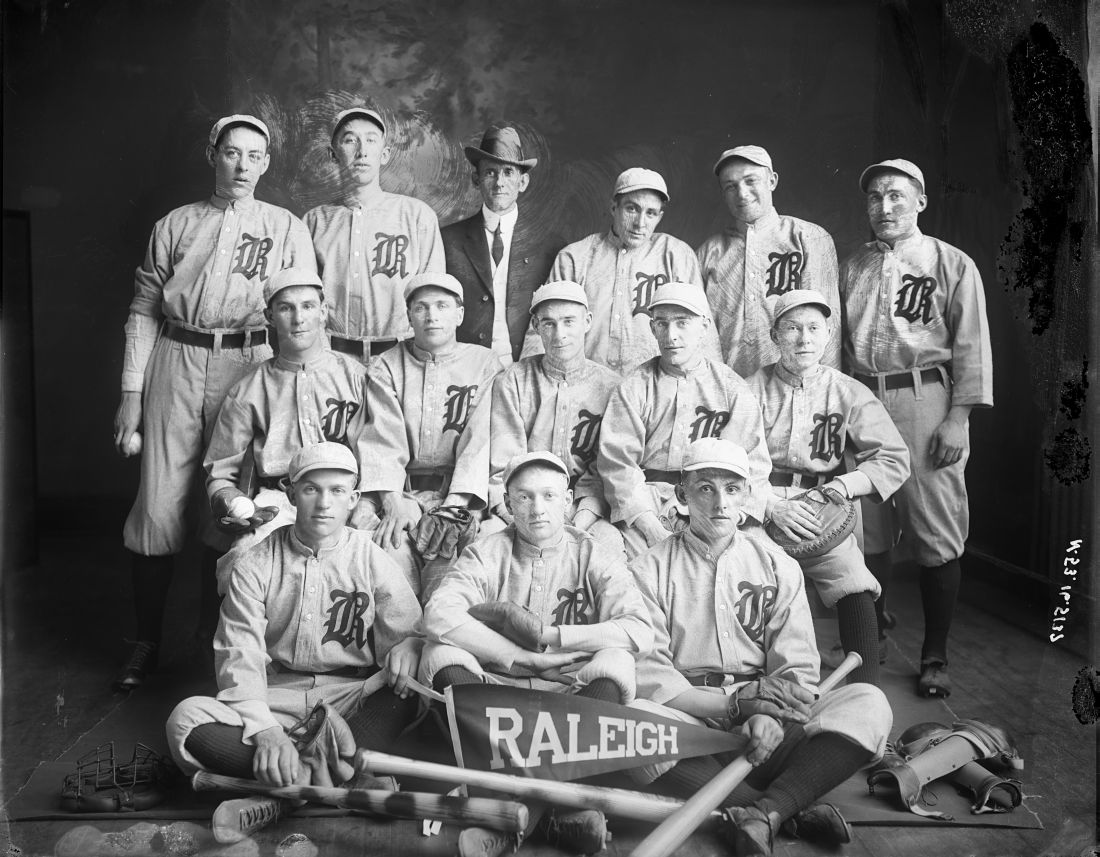 The 1913 Raleigh Capitals minor league baseball team. The team folded in 1932. (Courtesy of the State Archives of North Carolina)
The 1913 Raleigh Capitals minor league baseball team. The team folded in 1932. (Courtesy of the State Archives of North Carolina)
With an eye on better days, and using funds from the New Deal’s Works Progress Administration, in 1938 the city built a larger stadium, Devereux Meadow, atop an old playground. Wedged between Peace, West, and Dawson streets just north of downtown, it had the quirky dimensions of many street-squeezed urban ballparks of the era.
When the Carolina League restarted after World War II, the Capitals were reborn and joined high school and American Legion teams as tenants at Devereux. The next 15 years were the golden age of pro baseball in Raleigh.
Wyatt spent many days and nights at Devereux as a boy, as did Dwight Nipper, 77, another lifelong Raleigh resident. Nipper recalls being there when a game was paused in the third inning so Carl Yastrzemski, perhaps the greatest Capital ever, could receive the league’s Player of the Year award for 1959.
But moments like those and the park’s lyrical name were about all that was elegant about Devereux Meadow. Bleachers down the right-field line flanked a wooden grandstand with a tin roof. The expanse behind home plate, to every pitcher’s delight, was spacious, a final resting place for many foul balls. Pop-ups beyond the catcher’s reach would clang on the roof. “The frame and the restrooms, the dugouts, the whole park was painted dark green,” Nipper said.
“I actually think the lack of baseball has created a pent-up demand.”
Lou Pascucci, co-founder of MLB Raleigh
A batter might glimpse Raleigh’s modest skyline to the south over the wooden center-field fence, plus the Cotton Mill and a huge Philco-Bendix sign on a low hill. He also would see that fence’s distance marker, a forbidding 420 feet.
To the left was something more inviting—a two-story left-field wall with double rows of ads for such midcentury Southern icons as RC Cola and Jesse Jones sausage. Like the Green Monster that Yaz would later patrol at Boston’s Fenway Park, the wall was tall but tantalizing, just 315 to 325 feet away (accounts vary) at the foul pole. Behind it was Dawson Street, later named Downtown Boulevard and now Capital Boulevard, where homers often fell.
Raleigh won league titles in 1946 and 1947, and the large crowds in that era might have seen umpire Lou Bello giving hecklers as good as he got, or Durham Bulls player-manager Willie Duke appraising an ump’s visual acuity by dumping dirt over home plate.
Caps-Bulls “was a super rivalry, like State-Carolina,” Nipper said. “I remember how the fans got into it. We didn’t fight, but, I mean, we got into it.”
But Wyatt and Nipper were watching the autumn of pro ball in Raleigh.
“The heyday was the early ’50s,” Holaday said. “The team invested heavily in a lot of veteran players, including Crash Davis,” a former major leaguer from Gastonia who loosely inspired Kevin Costner’s movie character in the 1988 baseball classic “Bull Durham.” Jackie Robinson and Ted Williams played in exhibition games at Devereux that decade. The Caps finished first in the 1948, 1952, 1953, and 1959 regular seasons but lost each time in the playoffs.
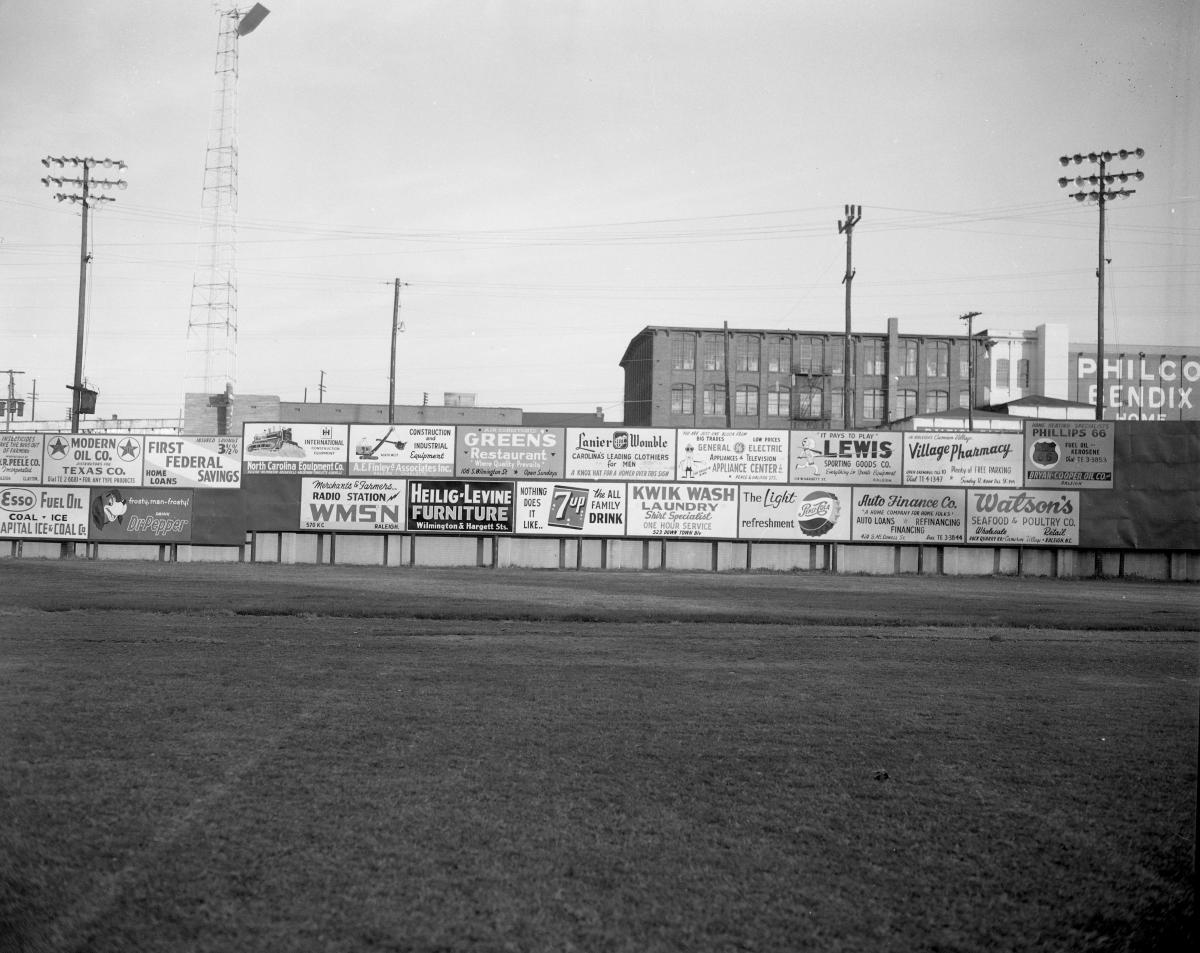 Ads line the outfield fence of Devereux Meadow in the 1950s. The ballpark was never elegant and eventually fell into disrepair. (Courtesy of the State Archives of North Carolina)
Ads line the outfield fence of Devereux Meadow in the 1950s. The ballpark was never elegant and eventually fell into disrepair. (Courtesy of the State Archives of North Carolina)
All the while, televised big league games kept more fans at home. Attendance fell from more than 2,000 per game in 1946 to less than 500—barely one in 10 seats filled—in the early ’60s. Years later, the Meadow was “often as quiet as a sanctuary,” News & Observer sportswriter A.J. Carr wrote in 1971.
The franchise held on through the ’60s as the Caps became the Mets, Senators, Cardinals, and Pirates before merging with the rival Bulls for four seasons beginning in 1968. They split home games between Devereux and Durham Athletic Park, bowing out as the last-place Raleigh-Durham Triangles.
Under gathering storm clouds from Hurricane Beth on a Sunday afternoon, August 15, 1971, just 205 souls watched the last minor league game in Raleigh, a 2-0 win over Lynchburg.
Devereux, which for a while continued to host Legion and high school baseball and football games, slowly crumbled. Saplings poked through the bleachers, and kudzu hid the restrooms. Rocks and glass were hazards on the field. A homeless man fell asleep in the scorer’s booth on a frigid night in February 1978 and never woke up. In 1979, the city demolished what was left and put up a parking lot for garbage trucks.
The 35-Mile Rule
No one knew it, but as Devereux fell, the window was closing for pro baseball in Raleigh for more than 40 years.
In 1980, Miles Wolff, who grew up in Greensboro and worked in minor league jobs around the South during the ’70s, scouted several cities looking for a team to buy. Those were “not great times for minor league baseball,” said Allan Simpson of Durham, who founded the publication Baseball America. “You could get a franchise by just assuming the debts of the previous owner.”
Wolff got his for $2,417, choosing to resurrect the Bulls in Durham, where the ballpark still stood. “It was pretty run down,” Simpson said, “but it was there”—while Raleigh had no place to play. The Bulls under Wolff quickly became a leader in the renaissance of minor league baseball nationwide.
Raleigh’s best shot came in the late 1980s. Tom McCormick, who was city attorney for 40 years, and his friend and fellow lawyer Clyde Holt III started a group called Friends of Raleigh Baseball and began going to baseball’s national winter meetings to scout the possibilities.
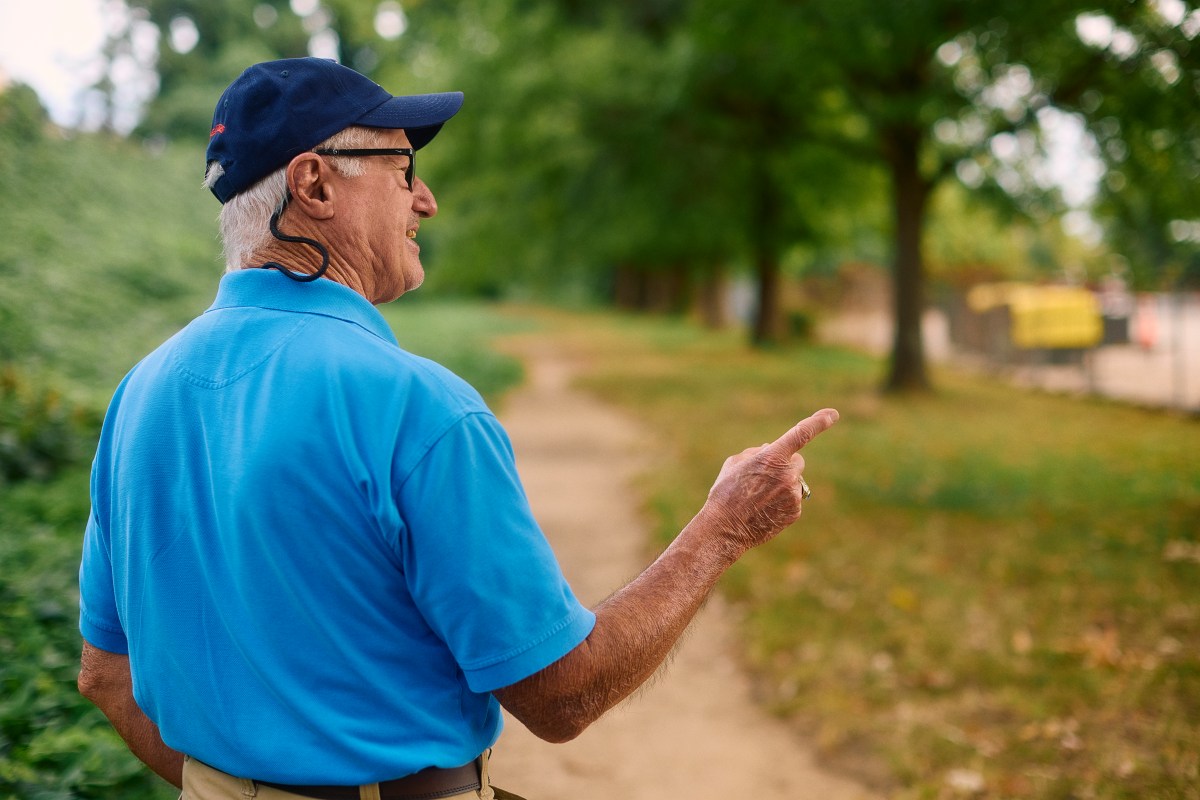 Dwight Nipper recalls attending games at Raleigh’s Devereux Meadow stadium, which was demolished in 1979. (Tyler Northrup for The Assembly)
Dwight Nipper recalls attending games at Raleigh’s Devereux Meadow stadium, which was demolished in 1979. (Tyler Northrup for The Assembly)
McCormick helped secure a referendum on $3.5 million in bonds to build a stadium, and voters approved it in October 1987. Days before the vote, Kinston Indians owner Stuart Revo expressed interest in moving his Carolina League team to Raleigh, and in compensating Wolff for attendance losses. “We had discussions,” Wolff, 81, told The Assembly. “I didn’t like it, but it was going to be tough to fight, to keep baseball out of Raleigh.”
But Raleigh’s City Council rejected Revo, favoring a plan by advertising executive Steve Bryant and former major leaguer Barry Foote to bring a higher-level, Class AA team. It was a consequential decision.
At that time, baseball’s rules wouldn’t allow a new team in a city whose corporate limits were within 10 miles of an existing team’s city.
“I took a close look at the rule, and it talks about building a stadium within the city limits,” McCormick said. “So it occurred to me that, maybe if we built it outside the city limits … ” The minor leagues’ general counsel agreed with his interpretation. A site beside North Carolina State University’s Carter-Finley Stadium was then outside the city, and it was available.
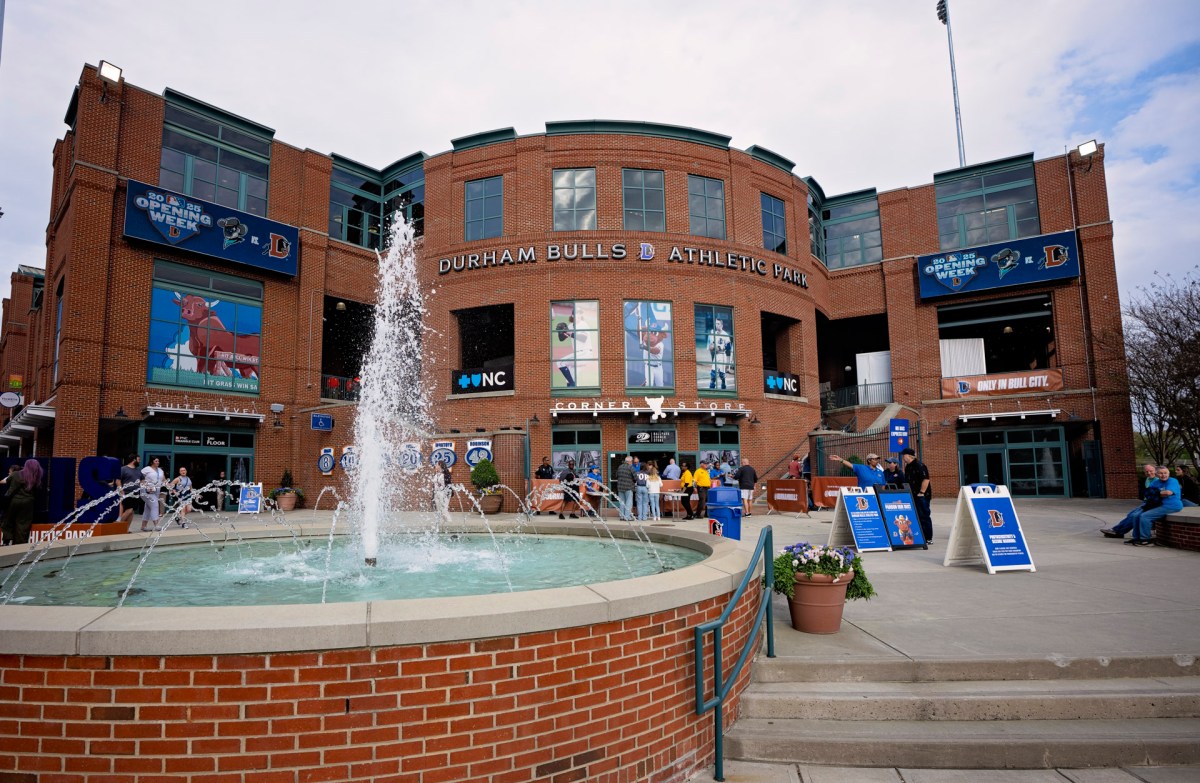 Outside the Durham Bulls Athletic Park in April 2025. (Cliff Hollis for The Assembly)
Outside the Durham Bulls Athletic Park in April 2025. (Cliff Hollis for The Assembly)
But Wake County was crucial to the Bulls. About a third of their fan base was there, “and we were Class A,” Wolff said. “I thought we’d get buried.” So in 1988, Wolff persuaded his fellow team owners to change the rule by prohibiting a new team whose home plate would be within 35 miles of another team’s home plate. Wolff also wouldn’t grant the Raleigh group a waiver.
Bryant and Foote had bought a team in Columbus, Georgia, and in 1991 they renamed it the Carolina Mudcats and moved it to Zebulon, just outside the 35-mile limit—and 21 miles east of downtown Raleigh. The Bulls, meanwhile, helped lead the rebirth of downtown Durham after Wolff agreed to sell them in May 1990 to Jim Goodmon Sr., president of Capitol Broadcasting Company. The city of Durham, fearing the Bulls might move, found the money to build a new downtown stadium, Durham Bulls Athletic Park, which opened in 1995, and in 1998 the franchise moved up to Class AAA, the highest level of minor league ball.
There were other proposals in Raleigh, including one in 1991 to build a baseball stadium as part of a huge sports and entertainment complex around Carter-Finley. None ever came to fruition, and the territorial rule remained a hurdle.
“Raleigh has paid the price for something that was established in 1988, and was probably outdated by 1998,” said Ron Morris, former sports journalist and author of No Bull: The Real Story of the Durham Bulls and the Rebirth of a Team and a City.
“When (people) think of Raleigh: ‘What do you mean, Raleigh? What’s there?’ I think we need some sort of a tag. Maybe ‘Tech City.’”
Michael Walden, professor emeritus at NC State
Finally, 10 years ago, Dan Thomson, a commercial real estate broker based in Raleigh, began pushing a plan that would have skirted the territorial rule. The idea was to field a team in the independent Atlantic League, an official MLB Partner League not bound by the rule, with a talent level comparable to the high minor leagues. The league has teams from New York to North Carolina, including the High Point Rockers and the Gastonia Ghost Peppers.
Thomson, now 51, pitched the idea to developers, council members, city officials, potential investors, and Atlantic League leaders.
He got a civil engineer to look at the Devereux site and found that it wouldn’t work. “So I go on this massive escapade of searching for land,” he told The Assembly, and John Kane, who was redeveloping the North Hills area, mentioned a possible site there.
“Then, all of a sudden, my phone rings, and it’s an architect from Populous,” a global firm that designed the new Yankee Stadium and the Mets’ Citi Field, “and they were gracious enough to do some stadium renderings.”
Thomson then looked into a crucial piece: funding. He checked municipal bond rates and looked at the Raleigh-Wake interlocal fund, which takes applications for money from a hospitality tax to fund capital projects involving culture, sports, and tourism.
There were a lot of projects in line ahead of him, and then COVID hit. He shelved the idea.
Edge Over Charlotte
Advocates for a Raleigh MLB team know about its losing streak, but “I actually think the lack of baseball has created a pent-up demand,” Pascucci said. They also argue that Raleigh in 2025 would be unrecognizable to a time traveler from 1971, and that the team would be a regional and even statewide draw. North Carolina is the largest state without an MLB team.
Pascucci noted that the population within an hour’s drive of Raleigh is larger than that of all other expansion contenders, and even five current MLB markets: Milwaukee, Cincinnati, Pittsburgh, St. Louis, and Kansas City.
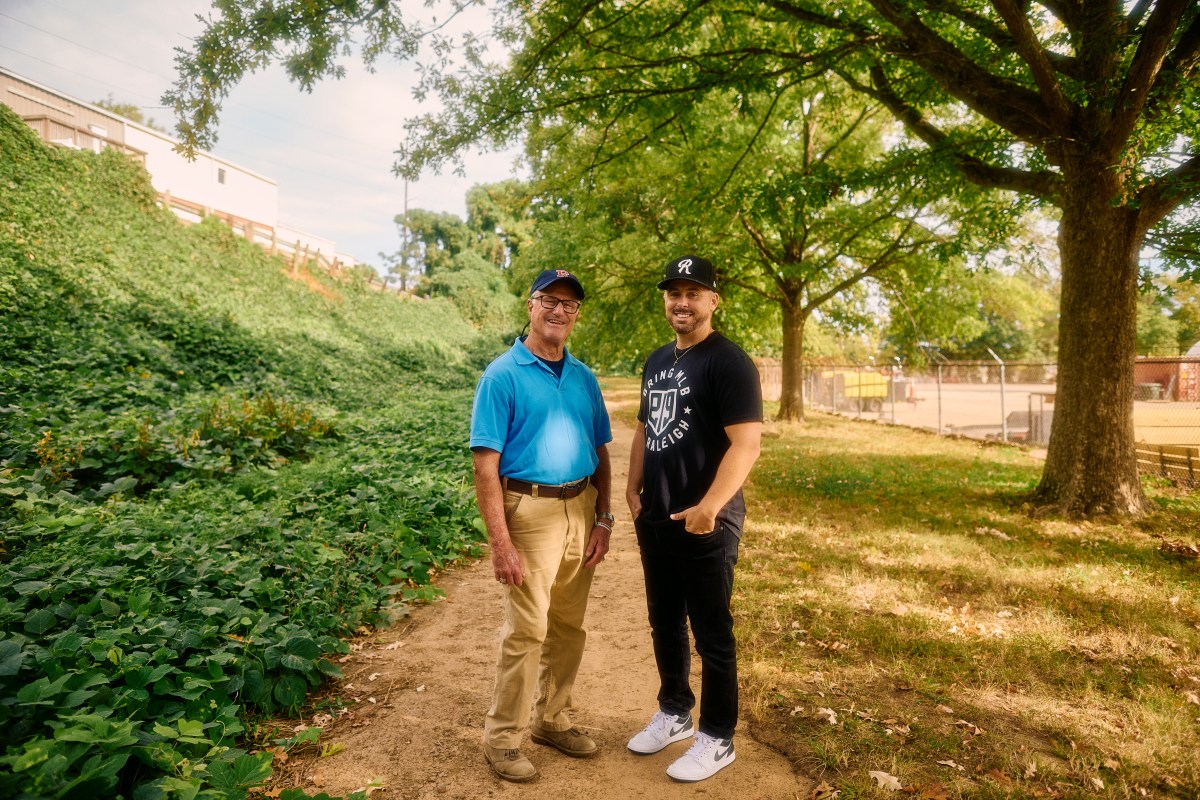 Lou Pascucci, co-founder of MLB Raleigh, and Dwight Nipper near the few structures left of the old Devereux Meadow baseball stadium. (Tyler Northrup for The Assembly)
Lou Pascucci, co-founder of MLB Raleigh, and Dwight Nipper near the few structures left of the old Devereux Meadow baseball stadium. (Tyler Northrup for The Assembly)
Manfred has said that, ideally, one new team would be in the East and one in the West. ESPN last year named Charlotte, Montreal, Nashville, Orlando, and Raleigh as the eastern contenders, but The Athletic in August narrowed the list to Nashville, Orlando, and Raleigh, saying Raleigh had more momentum and political support than Charlotte. A senior MLB writer for The Athletic, Stephen Nesbitt, has since trimmed it to Raleigh and Nashville.
In August, Michael Walden, an economic consultant and professor emeritus at NC State, independently did a feasibility and impact study of the contenders that further fortified Raleigh’s case. His data give Raleigh a slight edge over Charlotte, he told The Assembly.
Walden said Raleigh’s standout assets include anticipated growth, distance from an existing franchise, a prospective owner, and only a small overlap with the schedules of other popular area sports. Charlotte residents came out a little ahead in average weekly earnings, adjusted for cost of living ($1,060 to $1,015, with Nashville at $987) and media market size (Charlotte is 21st in the country, Raleigh 22nd, and Nashville 26th).
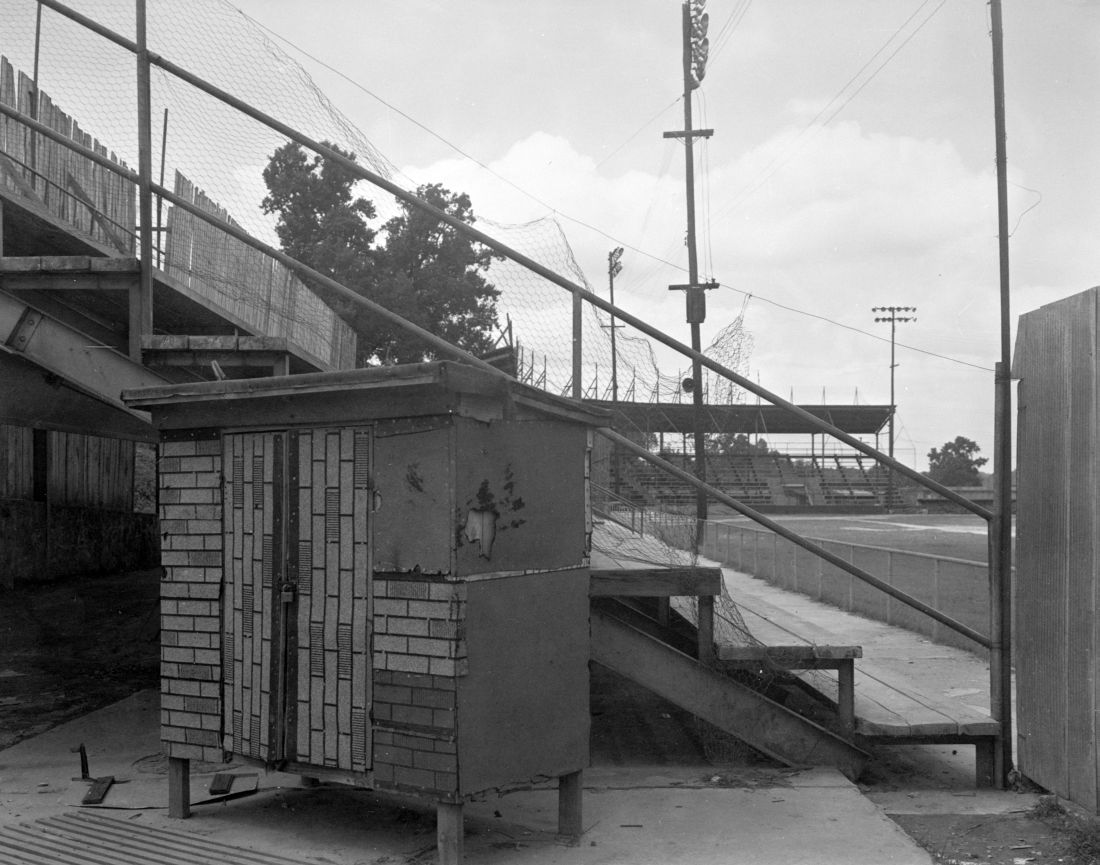 A view of the bleachers and a utility shed at Devereux Meadow in 1947. (Courtesy of the State Archives of North Carolina)
A view of the bleachers and a utility shed at Devereux Meadow in 1947. (Courtesy of the State Archives of North Carolina)
Another Raleigh asset is the number of transplants who have brought their team loyalties and love of the game to North Carolina. Of the 12 most common states of origin for recent transplants, nine—California, Florida, Georgia, Maryland, Massachusetts, New York, Ohio, Pennsylvania, and Texas—have a total of 18 MLB teams. The same phenomenon helped to sustain the Hurricanes in their early years.
As for the Durham Bulls, Goodmon has said that by agreement with MLB, the Bulls cannot block a major league team in Raleigh. Pascucci notes that other Triple-A teams have thrived in MLB markets, including Atlanta, Boston, Houston, and Minnesota.
Walden did mention one potential drawback. “I’d call it an image issue,” he said. “When you think of Nashville, everyone knows Nashville: ‘Oh, Music City.’ Raleigh is actually bigger than Nashville and is projected to grow faster. … When they think of Raleigh: ‘What do you mean, Raleigh? What’s there?’ I think we need some sort of a tag. Maybe ‘Tech City.’”
Raleigh’s biggest asset, analysts say, is having a principal owner lined up.
When Dundon, with other investors, reached a tentative agreement this summer to buy the NBA’s Portland Trail Blazers, many Raleigh enthusiasts thought he had taken his eye off the ball. But sports talk and podcast veteran Joe Ovies says the contrary is probably true: “He’s trying to tell Major League Baseball, ‘I can put together a legitimate ownership group. I can do this.’”
Eric Frederick has been a reporter, editor, and news audience strategist in North Carolina for more than four decades.
Are you signed up for The Assembly’s free North Carolina newsletter?
Every Monday, Wednesday, and Friday, you’ll get:
🗞 The news you need
📝 Stories from across the state
📚 Delivered directly to your inbox
Sign up today — it’s free!

